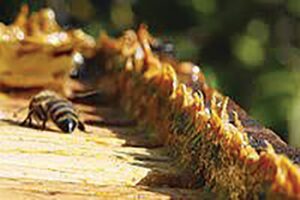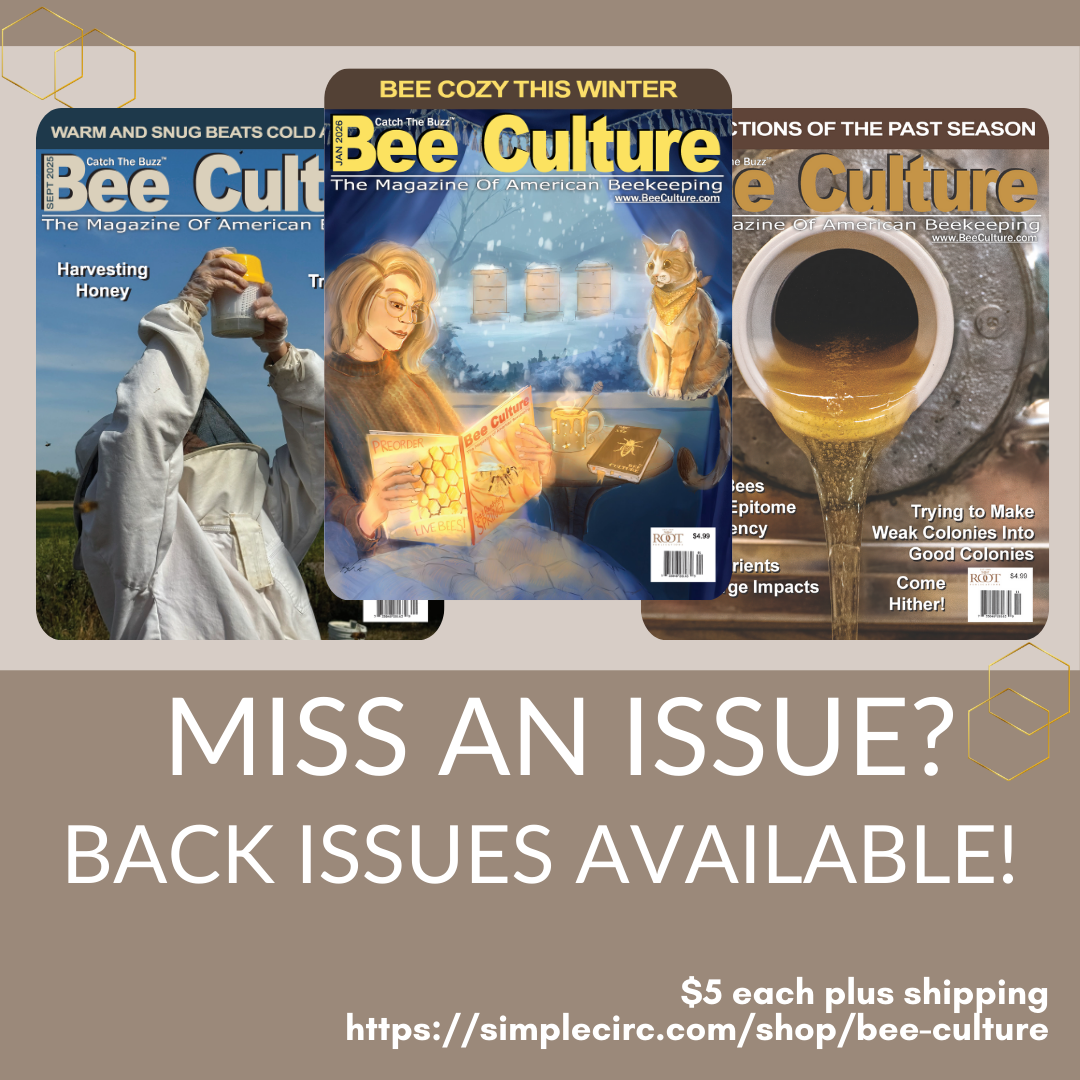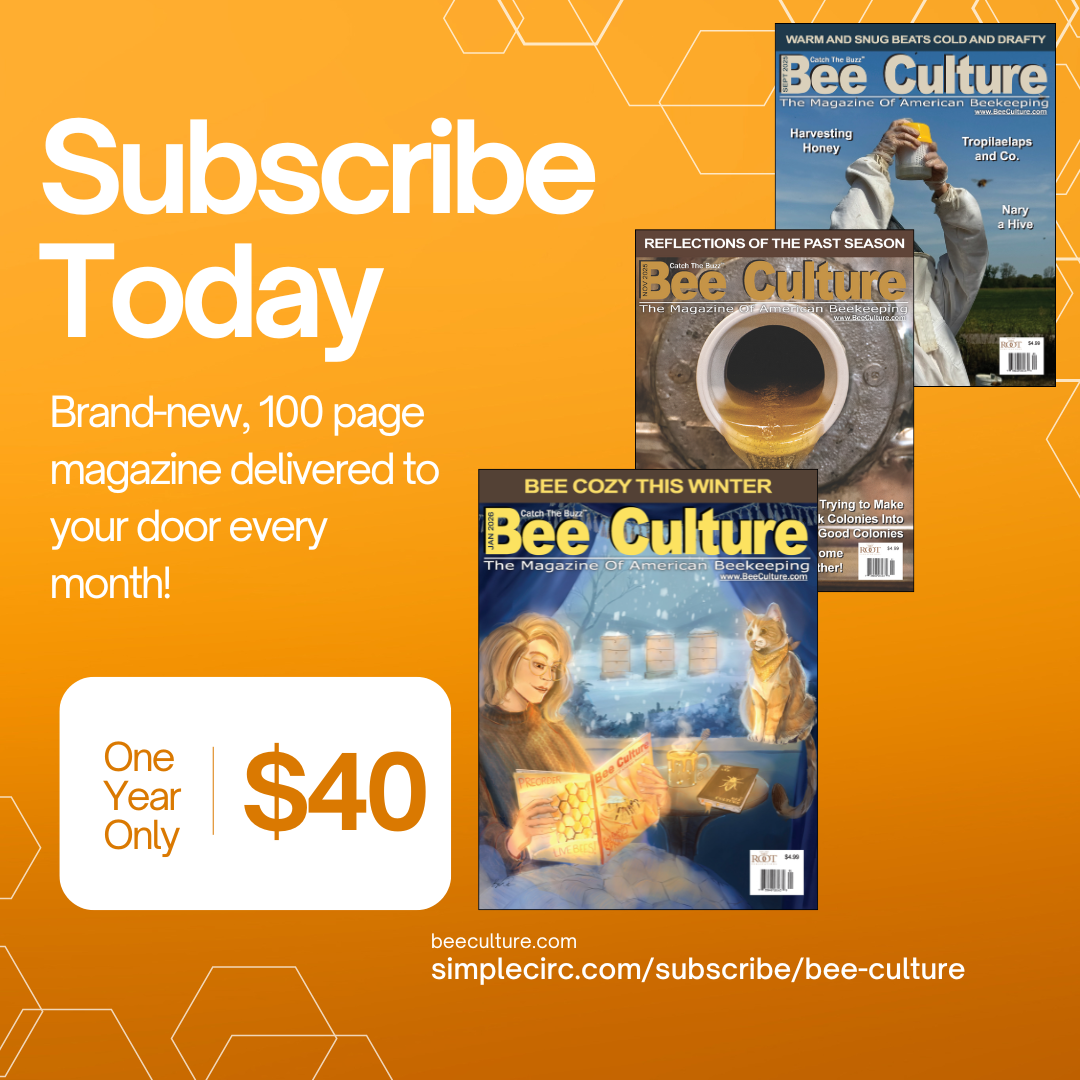Alexandra Nastasa
Reprinted with thanks to BeeScene and the BC Honey Producers.
Somewhere in a Dutch laboratory, bees are reportedly being trained to test for COVID-19. Coaxed into smelling samples, they’re rewarded for positive identification with sugar syrup in a textbook effort to harness animal senses using classical conditioning (InsectSense and Wageningen Bioveterinary Research 2021). It’s just the newest in a string of attempts to reap medical wisdom from the animal world stretching back throughout human history, attempts that have often been dazzling successes. But before we turn to the (unspecified) bees to solve our human health problems, there are first questions to be asked about the medical wisdom (or folly) of bees when it comes to their own health.
Medication is an integral part of the modern human experience. From the occasional Advil before a physically demanding dance performance to lifesaving insulin, human beings have developed therapeutics that change the way our bodies interact with problems and pathogens that might otherwise have been incapacitating – and we aren’t the only animals to do so. Scientists define self-medication in the animal kingdom according to these rules: 1. the medicine is purposely sought out; 2. the medicine hurts the pathogen; 3. the medicine helps the animal; and (somewhat debatably) 4. in the absence of illness, the medicine hurts the animal, creating a trade-off (Spivak et al. 2019). When it comes to eusocial animals like honey bees and bumblebees, however, the question of self-medication is complicated by the group structure of a hive. Unlike most animals generally discussed when talking about self-medication (such as primates, birds, and elephants), the functional unit of these species is not the individual but rather the hive, and this leads to shifting definitions of cost and benefit: to the part, and to the whole.
On an individual bee level, self-medication in honey and bumblebees makes plenty of sense. The primary sources of nutrition for bees, nectar and honey, have been shown to have vast assortments of active proteins, volatiles and other phytochemicals that vary between plant species, and both honey and bumblebees should be able to detect potential medicines in these nectars and pollens even at low concentrations, due to their sensitive sense of smell (Schmitt et al. 2021). Honey bees are also known to remember the location of quality floral resources and could likely remember more specific characteristics of these resources. In other words, all the equipment is there; the trouble appears to be that the bees refuse to be seen using it.
Over the last decade (and stretching back several more), numerous papers have characterized the effects of naturally occurring plant compounds on various bee pathogens. In bumblebees, sunflower pollen (specific chemical as yet unknown), the iridoid glycoside catalpol, as well as the alkaloids anabasine and gelsemine, have been shown to reduce loads of Crithidia bombi, an intestinal parasite (Adler et al. 2020, Richardson et al. 2015, Schmitt et al. 2021). Coumaric acid had antimicrobial effects on American foulbrood without being overly toxic to honey bees (Szawarski et al. 2020). Honey bee survival of Israeli acute paralysis virus was improved by dosing with caffeine at naturally occurring levels, and a mixture of caffeine and arginine was shown to even improve honey bee learning (Hsieh 2020, Marchi et al. 2021). Many of these studies have also confirmed the toxic effects of these compounds in higher concentrations or in the absence of a pathogen. However, evidence for the first criterion of self-medication – the most important – is lacking. Pathogen-dependent bee choice of nectar or pollen has not, thus far, been confirmed in scientific publications.
Although many studies of medicinal phytochemicals have tested for bee choice, the majority have failed to find any significant preference and few results actually support its existence. One study found an increased likelihood of a second visit to a flower containing higher concentrations of a medicinal compound in bumblebees parasitized by Crithidia bombi (Richardson et al. 2016). Another found that nurse honey bees infected with Nosema ceranae regularly chose sunflower honey over sugar syrup and other honey options, while healthy nurse bees did not show the same preference (Gherman et al. 2014). These findings, in particular the second, are promising indicators that honey bees may be able to make strategic choices based on their health and medicate themselves, or in the case of nurse bees, even those around them, but they are not, on their own, conclusive evidence of honey bees seeking out or having an understanding of medication, especially since far more choice assays have failed to show a pathogen-dependent effect.
The lack of cooperation (or perhaps the outright lack of self-medication instincts) on the part of individual bees suggests that an interrogation of social immunity and medication might be more successful. Eusocial bee behaviour frequently supports a “hive over individual” mentality in defensive behaviours like self-sacrificial stinging, and social immunity behaviours like hygienic behaviour. And the potential for social medication among honey bees in particular is high; honey storage is often well-organized by nectar source and can be accessed and used on larvae, young adults, queens, and drones by nurse bees, providing the perfect vehicle for medicating most of the hive, provided the nurse bees can differentiate between the honeys and select for certain characteristics, which there is some evidence for (Erler and Moritz 2016, Gherman et al. 2014). The closely shared space of a bee hive also makes these sorts of social immunity behaviours vital to hive survival, since the proximity and genetic similarity of the bees would otherwise make them extremely susceptible to disease and parasites (Spivak et al. 2019).

One well-known strategy that bees use to reduce the spread of pathogens in such close quarters is propolis, which acts as a sort of blanket antibiotic, partially sterilizing the hive environment (Simone-Finstrom and Spivak 2012). Multiple species of eusocial bees, including the Western honey bee, have significantly reduced immune activity in the presence of more propolis, suggesting that propolis acts a little like an external immune system protecting the whole hive (Pusceddu et al. 2019). Bees fed propolis have also shown decreased pathogen loads, although so far there is little evidence that bees ever purposefully eat propolis, except accidentally while consuming pollen (Mura et al. 2020). Most excitingly, however, propolis is the most convincing avenue for social medication. Propolis gathering in hives was shown to increase due to both increased Varroa mite counts and chalkbrood (Pusceddu et al. 2019, Simone-Finstrom and Spivak 2012). This behaviour was a clear response to the hive’s condition and reduced the number of pollen foragers available to the hive, which can be considered a negative side effect, while also causing a decrease in the hives’ pathogen loads (Erler and Moritz 2016, Simone-Finstrom and Spivak 2012). The propolis gathering response fulfills all four requirements for “self”-medication, provided that we consider the whole hive the “self”.
Although propolis gathering is not as recognizable a form of “medication” as seeking out therapeutic nectars might be, medication in the human world can also involve a variety of creams, sprays, environment adjustments, etc. The intention shown in increased propolis gathering to control outbreaks in the hive is still fascinating, and further reinforces a “superorganism” way of thinking about eusocial bee behaviour because it tackles the needs of the hive over those of the individual. As for the nectars, pollens, and honeys, research is ongoing and the articles reviewed here are by no means exhaustive. Each compound found to improve bee health is another potential candidate for less harmful therapeutics beekeepers might be able to treat hives with in the future, even if the bees do not seek them out themselves. The question of bee self-medication is still understudied, but expanding it to include social medication can only improve our ability to understand eusocial bee defenses. And although the usefulness of bees in sniffing out COVID-19 is still up in the air, the lessons we can learn about how to protect a highly social community are perhaps worth a listen.
References
Adler, L. S., Fowler, A. E., Malfi, R. L. et al. (2020). Assessing Chemical Mechanisms Underlying the Effects of Sunflower Pollen on a Gut Pathogen in Bumble Bees. J Chem Ecol, 46: 649–658.
Erler, S. and Moritz, R. F. A. (2016). Pharmacophagy and pharmacophory: mechanisms of self-medication and disease prevention in the honeybee colony (Apis mellifera). Apidologie, 47(3): 389-411.
Gherman, B. I., Denner, A., Bobiş, O. et al. (2014). Pathogen-associated self-medication behavior in the honeybee. Apis mellifera. Behav Ecol Sociobiol, 68: 1777–1784.
Hsieh, E. M., Berenbaum, M. R., and Dolezal, A. G. (2020). Ameliorative Effects of Phytochemical Ingestion on Viral Infection in Honey Bees. Insects, 11: 698.
InsectSense and Wageningen Bioveterinary Research (2021). Training bees to smell the coronavirus. https://www.wur.nl/en/Research-Results/Research-Institutes/Bioveterinary-Research/show-bvr/Training-bees-to-smell-the-coronavirus.htm
Marchi I. L., Palottini F., and Farina W. M. (2021). Combined secondary compounds naturally found in nectars enhance honeybee cognition and survival. J Exp Biol., 224(6): jeb239616.
Mura, A., Pusceddu, M., Theodorou, P., et al. (2020). Propolis Consumption Reduces Nosema ceranae Infection of European Honey Bees (Apis mellifera). Insects, 11: 124.
Pusceddu, M., Piluzza, G., Theodorou, P., et al. (2019). Resin foraging dynamics in Varroa destructor-infested hives: a case of medication of kin? Insect Sci., 26(2): 297-310.
Richardson L. L., Adler L. S., Leonard A. S., et al. (2015). Secondary metabolites in floral nectar reduce parasite infections in bumblebees. Proc. R. Soc. B, 282: 20142471.
Richardson, L. L., Bowers, M. D., and Irwin, R. E. (2016). Nectar chemistry mediates the behavior of parasitized bees: consequences for plant fitness. Ecology, 97(2): 325–337.
Schmitt, A., Roy, R., and Carter, C. J. (2021). Nectar antimicrobial compounds and their potential effects on pollinators. Current Opinion in Insect Science, 44: 55–63.
Simone-Finstrom, M.D., and Spivak, M. (2012). Increased Resin Collection after Parasite Challenge: A Case of Self-Medication in Honey Bees? PLoS ONE, 7(3): e34601.
Spivak, M., Goblirsch, M., and Simone-Finstrom, M. (2019). Social-medication in bees: the line between individual and social regulation. Current Opinion in Insect Science, 33: 49-55.
Szawarski, N., Giménez-Martínez, P., Mitton, G. et al. (2020). Short communication: Antimicrobial activity of indoleacetic, gibberellic and coumaric acids against Paenibacillus larvae and its toxicity against Apis mellifera. Spanish Journal of Agricultural Research, 18(1): e05SC01.









